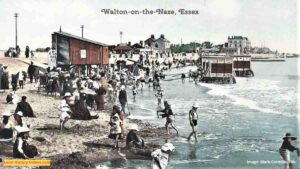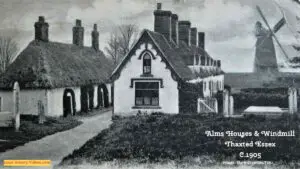Glimpse history through old images of Canvey Island, Essex, England.
Lighthouse Keepers 1951
A very brief newsreel from 1951 indicated how important the lighthouse was to the local yatch club and community.
Canvey Island Part Of News In Flashes (1951) – British Pathé on YouTube
Floods 1953
In 1953, about 10,000 of Canvey Island’s residents had to find temporary accommodation in nearby Basildon, as flood waters caused substantial damage to homes, shops and businesses.
Canvey Island Floods (1953) – British Pathé on YouTube
Historic Book
Extract from:
Transactions of the Essex Archaeological Society – Volume 4
by Essex Archaeological Society
Published in 1893
Pages 141 – 142
Among the State Papers (Dom. Ser.) are the following letters relating to this event:
June, 1667. Chelmsford. Sir John Bramston to William Herris, Lincolns Inn.
The alarm is hot enough. Sir H. and the greatest part of his regiment has marched to Lee; and the enemy has burnt houses and barns in Canvey Island, and are fallen back to the buoy of the Nore. Thinks they will attempt Wakering, Fouluess, &c. Sir James Altham says my lord’s regt will be at Chelmsford this evening. The town cannot supply them with gunpowder if they come without it, as it is presumed they will.
Harwich. 11 June. T. R [oss] to Williamson.
Their whole fleet except six have gone towards the river, and Sir Hen. Appleton writes that they have plundered Canvey Island. Many small boats attend them for the purpose. Thinks they mean little else than to steal sheep, which they attempted at St. Osyth, but retired when the people appeared. The militia are very cheerful for service.
June 11. Dover. Jo. Carlisle to Williamson.
It is said they have fired Lee in Essex: the guns were heard yesterday till 10 p.m.
Many unfounded rumors were flying about at the time, and this information was certainly erroneous.
June 14, 1667. Chatham. John Coney, Surgeon, to Williamson.
On the 9th, the enemy stood up towards the Hope. The 10th, this morning, fired several houses in Candia (Canvey Island in Essex). Canvey Island lies but a few miles below East Tilbury.
Sir Henry Appleton (the Sir H. referred to in Sir John Bramston’s letter) seems to have commanded a Militia Regiment. His seat was at Jervis Hall, South Bemfleet, though at this time he resided at Great Baddow. He was likely to be well-informed, as he had considerable property in Canvey Island. But the statements, as respecting Canvey, are corroborated by the Rev. George Maule, Rector of Vange, who had a farm there and could not be under a mistake when, on the 23rd September 1667, he, in his will, directed the residue of his goods, chattels, and plate to be bestowed “in erecting and new building of my house and barn on my farm in Canvey, lately burnt down by the Dutch.” His homestead was not more exposed than some others in the island and elsewhere, as high as Tilbury Hope. The traditional belief that the Tower of the church was destroyed by the Dutch is likely true, even if there’s no written record of it. There are orders and warrants for the militia to march to Leigh around the same time in the State Papers.
Having unanimously expressed their gratitude to the Vicar, Mr. Barter, for his diligent efforts in uncovering the buried foundations of the aisle and tower, and to Mr. Hayward for his informative lecture on the church, the gathering proceeded to the location where they had unearthed vast quantities of human remains. These remains had been placed outside the eastern boundary of the churchyard, and were uncovered during the construction of a military tramroad to the new fort. Evidently, these remains were of relatively recent origin, likely relocated from extensive charnel houses. Many of the bones exhibited signs of charring and had clearly been exposed to fire.
The Secretary ventured to offer a hypothesis given the sheer volume of remains that had been excavated and reburied. He suggested that these remains might have been transported from the vaults of London churches prior to their restoration following the significant fire of 1666. It was reasonable to assume that arrangements must have been made for the disposal of such remains. The proximity to convenient landing sites for transportation was noted, and it was apparent that they were deposited as close as feasible to the churchyard since it could not have accommodated them.
A kiln, appearing to be of Roman origin and containing a single large Roman tile, was discovered to be completely filled with these remains. However, there is no basis for assuming that these remains, which initially drew significant attention, were anything other than of relatively recent deposition. It is prudent to provide this clarification to prevent any future misconceptions or unfounded speculations. Given the substantial presence of Roman pottery remains along the river’s edge, there is a plausible inference that there were Roman pottery workshops in this area, similar to those at Upchurch on the Medway River banks.
More about Essex
- Old Images of Essex, England
- Old Images of West Hangingfield, Essex
- Old Images of Purfleet (Purfleet-on-Thames), Essex
- Old Images of Wickford, Essex
- Old Images of West Thurrock, Essex
- Old Images of Walton-on-the-Naze, Essex
- Old Images of Tilbury, Essex
- Old Images of Thaxted, Essex
- Old Images of South Ockenden, Essex









